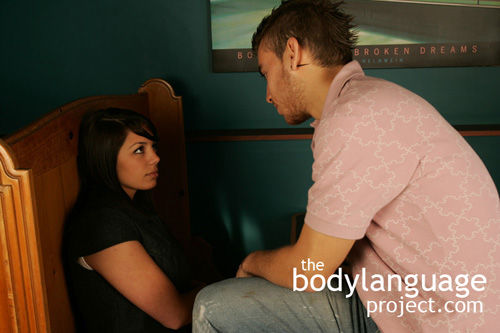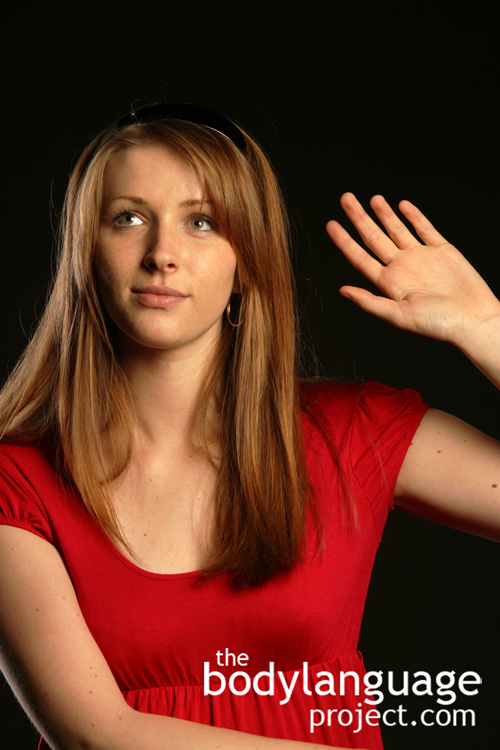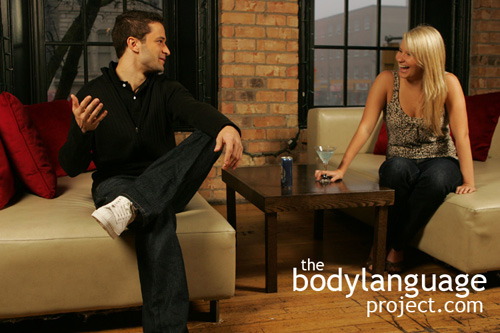When people meet and rejection is present we see:
[A] The disinterested party turns their body and head away at a half turn.
[B] An expressionless face is assumed.
[C] The toes are re-oriented away from the speaker toward an exit, or other people. Distance separating the speaker and listener may increase by taking a step away.
[D] Fidgeting increases, swaying from side to side, picking finger nails and so forth.
[E] Poor eye contact is present and the listener frequently looks away or down.
[F] No, infrequent, poor, or random regulators are given such as “mhum” and head nods.
[G] No engagement in the conversation, no addition of unique input.
[H] Opportunity to leave is actively sought despite lack of necessity.
Tag Archive for Regulators
Summary – Chapter 3
by Chris Site Author • March 5, 2013 • 0 Comments
In this third chapter we examined and compared the various influences on body language: genetic, learned and cultural. We found that in terms of genetics we all show similar roots and so display similarly across cultures, but that learning does play a role in how we might signal. We also covered emblems, illustrators, affect displays, adaptors and regulators which all form a part of what is called kinesics or how nonverbal behaviour relates to movement. Emblems, we found, are quotable gestures that are culturally specific which can be used as replacement for words and have a direct verbal translation. Illustrators are a second type of gesture that we use while speaking to help us paint a more descriptive picture such as talking about a boxing match and using a punching motion. Affect displays is nonverbal language that reveal our emotional state such as smiling or frowning and adaptors are movements or gestures that are used to manage our feelings or control our responses such as postural changes. Sometimes these adaptors have hidden meaning, but other times they do not, so caution is warranted. Regulators on the other hand control turn taking and flow when people speak with one another. Finally we covered high and low context cultures as it relates to touching and the ways various cultures meet and greet one another.
How To Use Regulators
by Chris Site Author • March 5, 2013 • 0 Comments
Regulators, regulate speech and control turn taking. Literally we can increase or decrease the amount of talking that happens with simple body language. For example, to increase speaking add more nodding. When people stop and you wish for them to continue simply nod your head, and, more often than not, this will encourage them to begin speaking again. The use of “mhums” and “yeses” will have the same effect. To speed speech up, or end a conversation altogether, send frequent looks away or down to your watch.
Too much nodding, on the other hand, shows indifference which can be a useful tactic depending on the speaker and your intent. Three nods in quick succession shows that you are ready to speak yourself and has the net effect of increasing their rate of speech to avoid being cut off. Drawing in air and parting the lips while tilting the head back slightly also gives the impression that someone is prepared to speak, as does patting the mouth with two fingers. Looking at your watch or looking to the doorway will make people talk less or if done excessively stop altogether.
Try this experiment. As your conversation begins nod your head every few seconds or as you see agreement. Next, increase the rate at which you nod your heard regardless of any agreement. What happens when you increase your nod frequencies? Most likely, up to about two to three continuous nods, they will become more excited believing they are building rapport. What if you nod continuously? I suspect it will stop the conversation altogether. Recall that three quick nods means that you wish to interject, while continuous nodding comes across as feigned agreement sending the conversation into a standstill. What happens with appropriate nodding absent of proper eye contact? This signals to others that their conversation is falling on deaf ears, and will be taken as an insult. The same goes with random nodding that has lost synchrony with speech. Telephone conversations easily fall off their rails if one party becomes preoccupied with another task. We immediately sense that their regulators have become unlinked from the conversation and when it comes time for them to speak, we hear nothing in return, or there is a delay. Not surprisingly, we find that the person on the other end is watching television – an obvious insult.
When people near the end of their though, and wish for their partner to speak, they will often lower their volume and slow their voice down slightly. Other times, the final syllable will be drawn out or gesturing with the hands will become less frequent or stop altogether. The eyes too are often lowered along with the head but at the very last moment eye contact will resume indicating that it’s time for the other person to begin speaking.
Raising the index finger can also signal a desire to speak which we learn early on in grade school which is normally accompanied by a sharp and deep intake of air. To stifle the “index finger interjector”, extend your hand across and make light contact with their forearm. This is a polite nonverbal way to show that you acknowledge their desire to speak, but that you haven’t quite concluded your point. If you sincerely wish to communicate interest and increase speaking, add a slight head tilt and a half frown or half-smile. This shows the speaker that what they have said is unclear but that you otherwise find it fascinating and wish to learn more.
Good communicators will make great partners amongst all types of speakers, even those that seem to carry on endlessly or those with little to say. They will have a strong arsenal of tools to cut one set of speaker off nonverbally, or as the case may be, encourage them to speak further. While we may take regulators for granted, conversations would be awkward and disjointed without them. Experiment a little for yourself and see how you can modify behaviour with regulators to suite your needs.
Regulators, Regulate Speech
by Chris Site Author • March 5, 2013 • 0 Comments
The final type of gestures are called regulators because they are used to modulate and maintain the flow of the speech during conversation. Essentially, we use regulators to control turn-taking in conversation and they can take the form of kinesic such as head nods or nonkinesic such as eye movements. Regulators are different across cultures more so than any other element of body language discussed thus far.
In a study by Marjorie Vargas in 1986, it was noted that black students in the United States felt insulted by the white educators. The educators weren’t picking up on cues that the students understood what was being instructed. For example, the white students would nod and murmur “uh-huh” but the black students would nod much less and use “mhm” instead. The teachers took this to mean that the students didn’t fully understand the material, but this wasn’t so, they just expressed their understanding differently.
In Japan, the up and down nod of the head or “yes motion” is utilized not to show ‘agreement’ but to show ‘understanding’. Therefore, while pitching a new idea or venture, it would be foolish to think that the continuous head nodding by the Japanese was do to their willingness to invest. Creating a simple dos and don’ts list is not feasible for these nonverbal kinesics in speech for the simple fact that there are far too many to list and the variation of meaning across culture is so varied. With the simple awareness of emblems, illustrators, affect displays, adaptors and regulators the incidence of misinterpreting their meaning can be reduced.
Caution is therefore important when dealing with international business so as to avoid any harm in interpretation. Some other examples of regulators include putting the hand up to signal that you are ready to speak, putting the finger up to the mouth to bring silence, waiving the hand around in a circle so as to speed things up, rolling of the eyes showing disapproval, a gasp to show shock, throwing the hand to someone to include them in the conversation, or shaking the head disapprovingly. All these gestures control the flow and pattern of speech by directing, disapproving, speeding things up or slowing them down, and even cutting the speaker short.
Using regulators in speech is necessary to create seamless turn-taking and to avoid appearing rude, dominating or frustrating the people you are talking with. It prevents having to interrupt, eases the flow of speech and allows everyone to make the points they wish to make without having to cut each other off mid-sentence. The net effect of a good conversation is connectivity through the creation of seamless turn-taking.
Emblems, Illustrators, Affect Displays, Adaptors And Regulators
by Chris Site Author • March 5, 2013 • 0 Comments
Gestures are used in speech to convey information more efficiently or to express attitudes or emotions and as a body language reader they give us clues as to the speakers mental framework from which they speak. Beneficial byproducts of gestures include making speech occur more smoothly and increased liking between speakers and listeners. In the following section we will cover “kinesics” which is the subclass of nonverbal body language that is related to movement. Kinesics is probably the most talked about and most common type of body language but also the most easily confused cross-culturally.
The first full length study on gesture was published in 1644 by John Bulwer. He catalogued dozens of gestures and produced a guide on how to increase clarity and eloquence in public speaking. Further research has shown that some gestures are universal and therefore have ubiquitous meaning across cultures, while others only have local meaning. Other gestures are context specific so mean one thing in one place and can mean something entirely different elsewhere. Pointing, made by extending the index finger and balling up the rest of the hand for example, is one of the gestures that has the same meaning everywhere, but the okay-sign made by touching the index finger to the thumb and flaring out the remaining fingers, as we shall see later, does not.
Some cultures also tend to gesture, called “gesticulation” when used in speech, more or less often than others. For example, Italians are known to use a lot of gestures in speech whereas the English tend to use gestures infrequently. The English culture, on the other hand, deems high rates of gesticulation as being impolite. The high gesture cultures include Hebrew, French and Spanish.
The more social way for us to use our hands is to use them in concert with what is being said, although taken to extremes like the Italians, or lack thereof like the English, can be counterproductive. A balance between the two, will be the best case. The hands and arms add to the dialogue and liven it. Keeping your hands to your sides or your arms crossed tightly might be comfortable, but those that use their hands moderately while speaking appear intelligent and honest when viewed by others. Universally, closed posture come off as negative and anti-social no matter what kinds of truths spoken or positive feelings intended by the speaker. This is why it’s so important to be conscious of our gestures because even if we aren’t, others will be. Whether or not others bring closed body language to consciousness, is not relevant. Our impressions are created in others passively with no active thinking.
The various gestures have been broken down into five categories: emblems, illustrators, affect displays, regulators which we cover next.
Introduction – Chapter 3
by Chris Site Author • March 5, 2013 • 0 Comments
If you spend time traveling or do business in more than one country then this chapter will prove invaluable. Not all body language happens the same way all over the world. To some this revelation gives them ammunition against body language because they say that since it is not totally universal, it is not innate and therefore not predictive, however this is not so. While some body language crosses culture, other language does not, what is important though, it to know which is which. We will spend the following chapter looking at how body language varies from region to region and hence from culture to culture and you will see that some body language is learned while some innate or genetic.
As we progress we will look at how emblems, illustrators, affect displays, adaptors and regulators add colour to our language and as how to use them. We will also discuss how these facets of body language vary across regions. The two take-away messages from this chapter is that it is the sender that determines the accuracy of the message no matter what the culture, and that it is up to you to decide what it means, and that it is the culture in which we find ourselves which dictates what’s normal. In this context, normal is what tells us how we should comport ourselves. We will see that our innate body language dictates our culture, that some gestures are universal (and some are not) and that touching preferences and desire (or tolerance) to closeness is learned. Finally we will cover the ways in which cultures meet and greet one-another.



